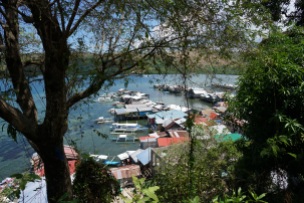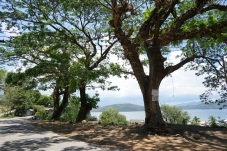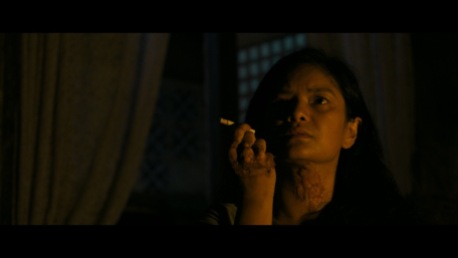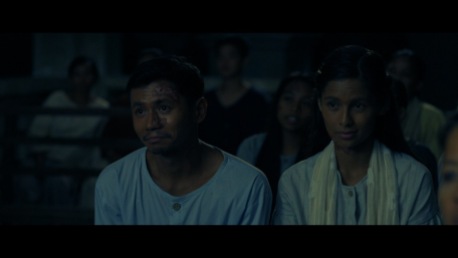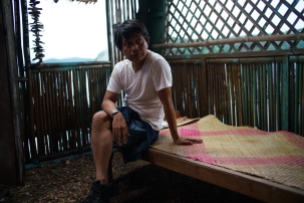CULION AND FALCON
July 15
Day 1
Heavy rains welcoming us at Culion pier.
Low pressure area in the Visayas
and has potential to become a tropical storm.
July 16
Day 2
Bad weather. Tropical storm Falcon will hit
landfall in the Babuyan Islands within 24 hrs.
Even as rain continue we checked the cave
location which is 1 hr away from the town and
a 20 minute hike and need to cross knee deep
water stream. We were all dripping wet by the
time we got back at the hotel. News of Skyjet flights
being rerouted back to Manila because of zero
visibility in Busuanga airport reached us in the
afternoon. With most of the supporting cast
and my lighting crew in that flight we need to
reshuffle scheduled sequences for Day 1.
July 17
Day 3
First shooting day still bad weather. I don’t have a
crew except my gaffer, key grip and my camera
department. After shooting our first shot heavy rains
forced us to abandon all our day exteriors scenes
and moved to interior scenes.
My journal entries on the first three days in Culion more or less defined what we had to endure during the next two weeks of our shoot. The weather fucked up the game plan and production needed to adjust on a daily basis based on weather condition. I give credit to the whole production team, never did I feel a sign of defeat, everybody was not backing down under any condition. With a storm coming and shooting a period film in an island in Palawan on a 15 day shoot with set constructions and prosthetics requirements, I just knew this is not my usual film shoot.
CULION MINUS THE POLITICS OF COLOR
I have never watched an Alvin Yapan film although I know his filmography is quite impressive. The first thing that I would usually do in this case is to watch the director’s films before we shoot and try to study his story-telling style. But when I learned that this is the first time that Alvin will be making a film he didn’t write, I decided not to. Confronted with all the givens – my first time to work with Alvin Yapan, my first time to shoot a Ricky Lee script, my first time to work with Shandii Bacolod’s Team MSB with Peter and Gilie Sing of IOPtions and my first time to shoot in the island of Culion for two weeks, I decided to make Culion an adventure both creatively and literally and let the universe take its natural course. I wanted to create something that’s raw and organic in the process with Alvin and the rest of the team.
Making a period movie is never easy. Besides the obvious huge task of the art department, there’s always a danger of falling to the usual cinematography cliche – let’s make it sepia slash desaturated approach. A conscious effort not to fall into this trap led me to some atmospheric inspirations and impressions when I first came to the island to do location check. Although my early idea was to make Culion with saturated colors reminiscent of 1940’s colorized photos and postcards, colorist Marilen Magsaysay did some tests and looked for some middle ground. It slowly evolved into more toned down colors for prosthetics to blend with the actors’ skin tone and the CGI with the live action.
Culion’s story evolves around three women isolated from the world because of Hansen’s disease just before World War II. Except for some urban development in the town center, I imagined the place looking pretty much the same in the late 1930’s – the landscape, the sea, the trees, the mangroves, the church overlooking the sea, the old school facing the pier, the white bench in the plaza. It is a place possibly frozen in time and devoid of the politics of color. But there is color in 1939 Culion – I see it as drab and gray, boring and dreary to the point of being colorless. During nighttime, there are patches of warm color coming from gas lamps. Production designer Erwin Sanchez’s sets and wardrobe also followed the same color path and complimented our overall visual treatment. Early in pre-production, Alvin and I discussed on how we intend to shoot Culion and its characters. We felt the need to humanize the characters, shoot them like any other human being without over emphasizing their condition. Cinematography is a very subjective art. It can either inform, disinform and sensationalize, however you choose it to be. How you position your camera, how you use the lens, how you light, reveals one’s biases and politics.
CULION IN COOKE PANCHRO
Camera : Panasonic Varicam LT
-This was my preferred camera because of the LT’s feature of having dual ISO rating of 800 and 5000. With mostly gas lamps as our light source in the film the ISO 5000 setting was very useful during night scenes with low light condition. I used small LED finger lights to fill in the shadows on faces whenever there is a need which comes with a flicker control to simulate the flicker of a lamp.
Lenses : Cooke Panchro/i Classic
-With the continuous rise of super clinical digital cinema lenses there has been a steady demand for a more ‘film’ or vintage look. I intentionally used old lenses or degraded the images of my last four films and Culion is not an exemption. Cooke deliberately altered the quality of the Panchro lenses giving a distinct bokeh and created a fall off focus on the edge creating an old feel. It basically makes the image imperfect which enhanced the film’s visual narrative.
Dream Sequence : Inspired by 16mm old footage, the dream sequences of Doris (Jasmine Curtis-Smith) were shot also with Varicam LT camera and the Panchro lenses created a nice flare coming from a 1.2 HMI light. The 1.33 aspect ratio and the film grain was done in post.

Generally, I approached Culion’s cinematography with restraint. Ricky Lee’s story is about humanity and the human condition and there’s so much happening dramatically I think its photography should not create attention to itself. Cinematography should not supersede or obscure an otherwise good story, cinematography is never about pretty pictures.
Behind the scenes :








